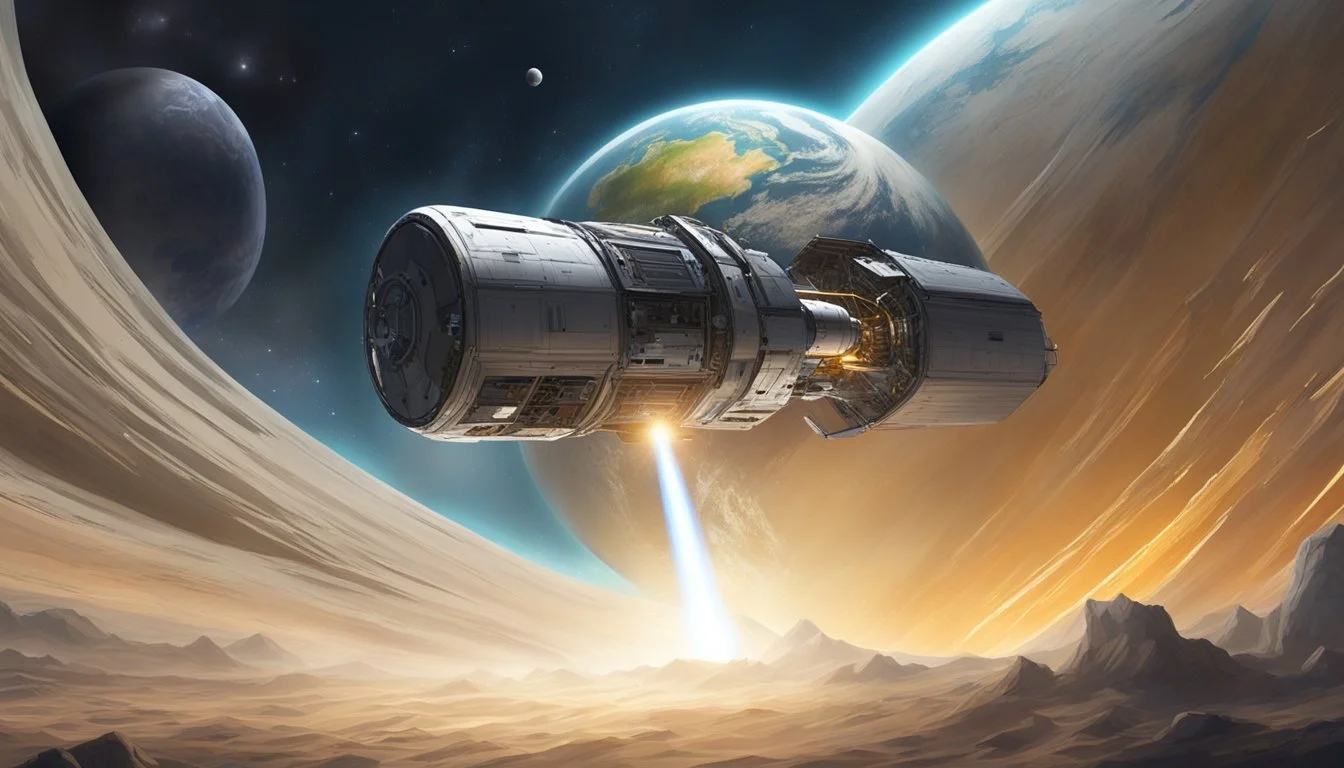Apollo 13: NASA's Real 'Successful Failure'
Triumph in the Face of Disaster
Apollo 13 launched on April 11, 1970, with astronauts Jim Lovell, Fred Haise, and Jack Swigert aboard. The mission aimed to be NASA's third lunar landing, targeting the Fra Mauro region of the Moon. What began as a smooth flight quickly turned into a harrowing struggle for survival.
Two days into the mission, an oxygen tank explosion crippled the spacecraft. NASA's quick thinking and the crew's resourcefulness transformed a potential disaster into what became known as a "successful failure." The focus shifted from landing on the Moon to bringing the astronauts home safely.
The Apollo 13 mission captivated the world's attention as NASA engineers and astronauts worked tirelessly to overcome seemingly insurmountable challenges. Their ingenuity and determination not only saved the crew but also demonstrated the resilience of the human spirit in the face of adversity.
The Apollo 13 Mission Overview
Apollo 13 launched on April 11, 1970, as NASA's third lunar landing attempt. The mission faced unexpected challenges that transformed it from a routine spaceflight into a dramatic struggle for survival.
Launch and Early Mission Operations
Apollo 13 lifted off from Kennedy Space Center atop a Saturn V rocket. The crew consisted of Commander Jim Lovell, Lunar Module Pilot Fred Haise, and Command Module Pilot Jack Swigert. Swigert replaced Ken Mattingly at the last minute due to potential measles exposure.
The initial launch and Earth orbit insertion went smoothly. The spacecraft successfully separated from the Saturn V's third stage and began its journey to the Moon.
Mission Control in Houston monitored the flight closely, maintaining constant communication with the crew.
The Unexpected Crisis
Approximately 56 hours into the mission, a routine stirring of the oxygen tanks caused a spark that triggered an explosion. The blast severely damaged the Service Module, venting oxygen into space and compromising the spacecraft's power supply.
Lovell reported the now-famous words: "Houston, we've had a problem."
The crew quickly realized the severity of their situation. With limited power, oxygen, and water, their focus shifted from lunar exploration to survival.
Mission Objectives and Alteration
The original mission plan included landing in the Fra Mauro region of the Moon. This objective was immediately abandoned after the explosion.
NASA engineers and astronauts worked tirelessly to devise a new flight plan. They decided to use the Moon's gravity to slingshot the spacecraft back to Earth.
The Lunar Module, designed for Moon landings, became a lifeboat for the crew. It provided essential life support systems for the return journey.
Apollo 13's new primary objective became the safe return of the astronauts. This required careful power management, improvised carbon dioxide filtration, and precise navigation calculations.
The Challenge of Survival
The Apollo 13 crew faced life-threatening obstacles that tested their resilience and ingenuity. Their survival hinged on careful resource management, precise navigation, and innovative problem-solving under extreme pressure.
Life Support and Resource Management
The explosion damaged the Command Module's life support systems, forcing the crew to use the Lunar Module Aquarius as a lifeboat. This unexpected situation created critical shortages of water, electricity, and breathable air.
Carbon dioxide levels rose dangerously as the Lunar Module's air scrubbers were overwhelmed. The crew improvised a makeshift air purifier using materials on board, including cardboard, plastic bags, and duct tape.
Water became scarce, with the crew rationing their intake to dangerous levels. They conserved electricity by shutting down non-essential systems, operating in near-freezing temperatures.
Navigating to Safety
The damaged spacecraft required a new trajectory to return safely to Earth. NASA engineers calculated a "free-return" path, using the Moon's gravity to slingshot Apollo 13 back home.
The crew performed critical manual burns to adjust their course, relying on Earth's terminator as a visual reference. This precision maneuver was essential, as even a small error could result in the spacecraft missing Earth entirely.
Navigation challenges were compounded by the need to conserve power. The crew had to repeatedly power up and down systems, maintaining just enough function for crucial course corrections.
Critical Repairs and Ingenuity
The astronauts faced the daunting task of adapting Command Module equipment to work with the Lunar Module systems. This included fitting the square carbon dioxide scrubbers from the Command Module into the Lunar Module's round receptacles.
Electrical power became a major concern. The crew devised a procedure to draw power from the Lunar Module's batteries to charge the Command Module's systems for re-entry.
As Apollo 13 approached Earth, the astronauts had to resurrect the cold, damaged Command Module. They executed a precise power-up sequence, overcoming condensation issues that threatened to short out the electrical systems.
The crew's resourcefulness extended to using the Sun for thermal control and creating an improvised insulation system using spare equipment bags.
The Return to Earth
Apollo 13's journey back to Earth was fraught with challenges. The crew faced critical power and life support issues while navigating their crippled spacecraft home. Their successful return hinged on precise calculations, innovative problem-solving, and flawless execution of re-entry procedures.
Re-Entry Procedures and Challenges
The Apollo 13 crew used the Sun for navigation, maintaining a free-return trajectory to Earth. Power conservation was crucial, with the Command Module shut down to preserve resources for re-entry. Engineers worked tirelessly to develop new procedures for powering up the spacecraft.
The crew faced uncertainty about the integrity of their heat shield. They had to perform a precise manual burn to adjust their trajectory and ensure a safe re-entry angle. This maneuver was executed with remarkable accuracy despite limited fuel and power.
Atmospheric re-entry posed significant risks due to the spacecraft's unconventional configuration. The Service Module was jettisoned, and the Lunar Module remained attached until the last possible moment to protect the Command Module's heat shield.
Splashdown and Recovery
As Apollo 13 plunged into Earth's atmosphere, tension mounted over the spacecraft's ability to withstand the extreme heat of re-entry. The crew experienced a nerve-wracking four-minute communications blackout before radio contact was re-established.
The Command Module successfully deployed its parachutes, slowing its descent for a safe splashdown in the Pacific Ocean. The USS Iwo Jima, serving as the primary recovery ship, quickly located and retrieved the spacecraft and its crew.
Astronauts Lovell, Haise, and Swigert were found to be in good health despite their ordeal. Their safe return marked the culmination of an extraordinary effort by NASA's ground teams and the astronauts themselves, transforming a potential tragedy into a triumphant demonstration of human ingenuity and perseverance.
Impact and Legacy
The Apollo 13 mission left an indelible mark on NASA and the world, shaping space exploration and safety protocols for decades to come. It demonstrated human ingenuity and perseverance in the face of extreme adversity.
Analysis of the Incident
NASA conducted a thorough investigation into the Apollo 13 incident. The root cause was traced to damaged Teflon insulation inside Oxygen Tank No. 2. This damage occurred during pre-flight testing when the tank was subjected to higher than normal temperatures. The compromised insulation led to exposed wires, which sparked and ignited the oxygen, causing the explosion.
The incident highlighted the need for more rigorous testing procedures and improved design of critical systems. It also underscored the importance of redundancy in spacecraft systems, as the backup systems proved crucial in bringing the astronauts home safely.
Lessons Learned and Safety Enhancements
Apollo 13 prompted significant changes in NASA's approach to space missions:
Enhanced testing protocols for all spacecraft components
Redesign of oxygen tanks to eliminate potential ignition sources
Improved wiring and electrical systems to reduce fire risks
Addition of a third oxygen tank on subsequent Apollo missions
Development of more comprehensive emergency procedures
These changes not only improved the safety of future Apollo missions but also influenced the design and operation of later spacecraft, including the Space Shuttle and International Space Station.
Cultural and Historical Significance
Apollo 13 captured global attention and became a symbol of human resilience. The mission's drama and successful recovery effort inspired books, documentaries, and the popular 1995 film starring Tom Hanks.
The phrase "Houston, we've had a problem" entered popular culture, often misquoted as "Houston, we have a problem." Flight Director Gene Kranz's statement, "Failure is not an option," became a rallying cry for determination in the face of adversity.
Apollo 13 also served as a reminder of the risks inherent in space exploration. It tempered public enthusiasm for the space program but simultaneously showcased NASA's problem-solving capabilities and the bravery of astronauts.
Conclusion and Reflections
Apollo 13's journey stands as a testament to human ingenuity and perseverance in the face of adversity. The mission, while failing to achieve its original lunar landing objective, succeeded in bringing the crew safely back to Earth.
NASA's swift response and problem-solving capabilities during the crisis demonstrated the agency's resilience and expertise. The coordination between astronauts and Mission Control showcased the power of teamwork in overcoming seemingly insurmountable challenges.
The Apollo 13 mission highlighted the inherent risks of space exploration. It served as a reminder that even with meticulous planning, unforeseen complications can arise in the harsh environment of space.
This near-disaster led to important improvements in spacecraft design and safety protocols. NASA implemented changes to prevent similar issues in future missions, enhancing the overall reliability of space exploration endeavors.
Apollo 13's story continues to inspire generations of scientists, engineers, and explorers. It underscores the importance of adaptability, creative thinking, and unwavering determination in pushing the boundaries of human achievement.
The mission's legacy extends beyond its technical aspects. It captivated global attention, uniting people worldwide in hope and support for the imperiled astronauts. This shared experience emphasized the universal nature of space exploration and its ability to bring humanity together.


